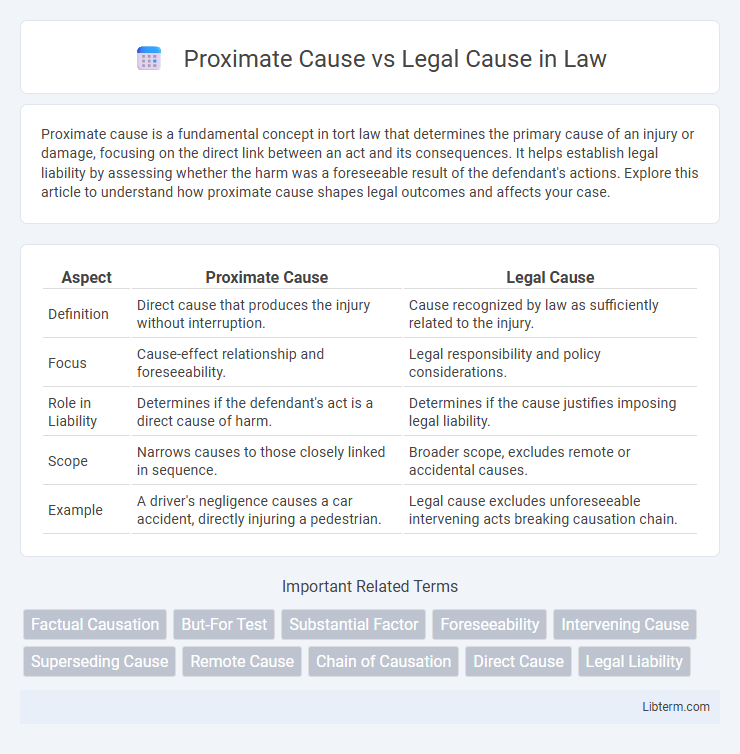Proximate cause is a fundamental concept in tort law that determines the primary cause of an injury or damage, focusing on the direct link between an act and its consequences. It helps establish legal liability by assessing whether the harm was a foreseeable result of the defendant's actions. Explore this article to understand how proximate cause shapes legal outcomes and affects your case.
Table of Comparison
| Aspect | Proximate Cause | Legal Cause |
|---|---|---|
| Definition | Direct cause that produces the injury without interruption. | Cause recognized by law as sufficiently related to the injury. |
| Focus | Cause-effect relationship and foreseeability. | Legal responsibility and policy considerations. |
| Role in Liability | Determines if the defendant's act is a direct cause of harm. | Determines if the cause justifies imposing legal liability. |
| Scope | Narrows causes to those closely linked in sequence. | Broader scope, excludes remote or accidental causes. |
| Example | A driver's negligence causes a car accident, directly injuring a pedestrian. | Legal cause excludes unforeseeable intervening acts breaking causation chain. |
Introduction to Causation in Law
Proximate cause and legal cause are fundamental concepts in tort law that establish the link between conduct and harm. Proximate cause limits liability to consequences closely connected to the defendant's actions, emphasizing foreseeability of harm. Legal cause serves as a broader principle ensuring that only those harms directly attributable to the defendant's breach are actionable under the law.
Defining Proximate Cause
Proximate cause refers to the primary cause of an injury, where the harm was a foreseeable result of the defendant's actions without an intervening cause breaking the chain of liability. It establishes a direct link between the defendant's conduct and the plaintiff's damages within the scope of legal responsibility. Courts evaluate proximate cause by determining whether the injury was a natural and probable consequence of the act, thus limiting liability to foreseeable risks.
Understanding Legal Cause (or Legal Causation)
Legal cause, also known as legal causation, refers to the determination of whether a defendant's actions are sufficiently connected to the harm suffered to hold them legally responsible. It involves assessing foreseeability and whether the harm was a direct result of the defendant's conduct without any intervening acts breaking the chain of causation. Courts apply the "proximate cause" concept to limit liability to consequences closely linked to the defendant's actions, ensuring fairness in attributing legal responsibility.
Key Differences Between Proximate and Legal Cause
Proximate cause refers to the primary cause that directly leads to an injury, emphasizing foreseeability and direct connection in tort law. Legal cause encompasses proximate cause but includes broader policy considerations to determine liability in negligence cases. The key difference lies in proximate cause focusing on causation and foreseeability, while legal cause integrates judicial discretion to limit liability.
Importance of Causation in Negligence Cases
Causation is a critical element in negligence cases, distinguishing proximate cause--the direct, immediate link between the defendant's actions and the injury--from legal cause, which addresses foreseeability and limits liability. Establishing proximate cause ensures that only harms closely connected to the defendant's conduct lead to liability, preventing limitless responsibility. Courts rely on causation to balance fairness and justice, confirming the defendant's actions were a substantial factor in the plaintiff's damages.
Foreseeability and Its Role in Proximate Cause
Foreseeability plays a critical role in determining proximate cause by establishing whether a reasonable person could predict the harm resulting from their actions. Proximate cause limits liability to consequences that are closely connected and reasonably foreseeable, preventing infinite accountability for distant or unexpected injuries. Legal cause encompasses proximate cause but includes other factors like actual cause, creating a comprehensive framework for causation in tort law.
The “But-For” Test in Determining Cause
The "But-For" test is a fundamental principle in determining proximate cause, asking whether the harm would not have occurred but for the defendant's conduct. Proximate cause limits liability to consequences closely connected to the act, ensuring legal cause applies where the "but-for" condition is met without excessive remoteness. Courts apply this test to establish direct causation while excluding remote or indirect effects unsuitable for legal responsibility.
Real-World Examples of Proximate and Legal Cause
Proximate cause refers to the direct, primary cause of an injury that is legally sufficient to result in liability, exemplified by a driver running a red light and hitting a pedestrian. Legal cause encompasses broader considerations of foreseeability and policy decisions, as seen in cases where an unforeseeable intervening event breaks the chain of causation, exempting the defendant from liability. Real-world examples include automobile accidents where proximate cause is clear, contrasted with medical malpractice cases where courts examine whether the harm was a foreseeable outcome of the original negligence to establish legal cause.
Challenges in Proving Causation in Court
Proximate cause and legal cause are critical concepts in tort law that establish the link between a defendant's actions and the plaintiff's injury, with proximate cause focusing on foreseeability and legal cause encompassing broader policy considerations. Challenges in proving causation in court often arise from the difficulty in demonstrating that the defendant's conduct was the actual and proximate cause of harm, especially when multiple factors contribute to the injury or when intervening events occur. Courts require clear and convincing evidence to establish this causal connection, making complex medical testimony, expert analysis, and factual discrepancies central obstacles in litigation.
Conclusion: Impact of Causation on Legal Outcomes
Proximate cause limits liability to consequences closely connected to the defendant's actions, whereas legal cause establishes the chain of events linking conduct to harm. The distinction affects legal outcomes by determining the scope of responsibility and compensation in tort cases. Courts analyze both proximate and legal causation to ensure fair attribution of liability, impacting verdicts and settlement negotiations.
Proximate Cause Infographic

 libterm.com
libterm.com